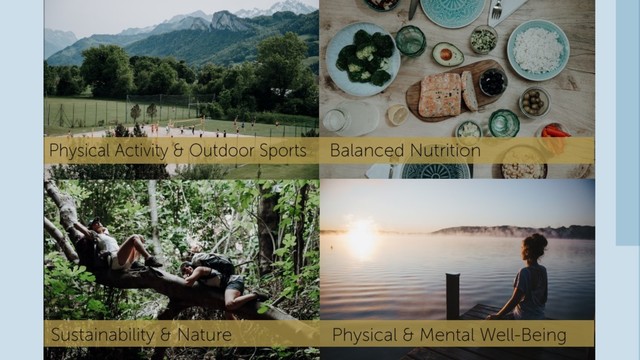Article
Correlation Among The 4 Pillars

How are they connected?
How nutrition and physical activity are connected, according to science
When it comes to a healthy lifestyle, the question often arises what comes first, nutrition or physical activity, or to be more specific, what is more important?
Despite the research suggestions, proper nutrition could have a compensatory effect, meaning that it could compensate for low physical activity. Still, quality diet cannot completely annul the negative consequences of physical inactivity (1,2). Just as being physically active cannot fully negate the harmful effects of bad/improper nutrition.
Generally speaking, nutrition and physical activity play a crucial role in health and development (3). Consuming a healthy diet, just as meeting adequate levels of physical activity, have a broad range of health benefits (2) They can prevent non-communicable diseases and conditions such as hypertension, coronary heart disease, diabetes, various types of cancer, and stroke, improve muscular and cardiorespiratory fitness, improve body composition, improve cognitive performance and mental health, as well as maintaining healthy body weight and improving quality of life and well-being across the lifespan (4,5).
Even though the importance of quality nutrition and sufficient physical activity levels are considered crucial factors for preserving and improving health status and quality of life, in the context of research, they are mostly monitored separately (5). On the other hand, to prevent non-communicable diseases and conditions and to promote a healthy lifestyle, it is necessary to take several health behaviors into account (2,6). That being said, it is evident that the integration of physical activity and nutrition has the potential to produce more significant benefits when compared to strategies focusing merely on one or the other (5).
Sustainability & nature – the effect on your physical and mental health
On the other side, the increased level of urbanization is leading human beings far away from their original natural environment. Losing the contact with nature isn’t the only concern: our improved lifestyle has endangered the natural ecosystem.
The global warming phenomenon has set up new challenges. These challenges, related to the uncertainty of our (and next generation) future, could cause psychological burdens (8,9): Stress could arise from our hectic lifestyle.
Is reconnecting with nature enough to restore our mental well-being?
Studies demonstrate how our physical and mental well-being are strictly related to our connection with natural environments (10). Research suggests two different theories which could explain the possibility of rebuilding mental well-being thanks to nature. The Attention Restoration Theory suggests that connecting with nature could restore our attention resources usually depleted (causing mental fatigue) due to our hyper connected lifestyle (11). The Stress Recovery Theory simply suggests the possibility of restoring from stress by staying in natural environment instead (11). The same theory also states that urban environment tends to mitigate this process. Recovering mental fatigue and psychological well-being is not the only advantage that nature connections could provide. Physical well-being could also be improved through exercising in natural environments (12).
Exercising in green environments may induce more enjoyment, but its effectiveness compared to indoor exercise should be further studied (13). Additionally, we should also reconnect with nature implementing sustainable actions: save/reuse natural resources could in this way reduce the feeling of being powerless about the uncertainty of the future.
In the end, it is clear: Our physical and mental well-being strictly depends on our connection with nature, and we cannot ignore this any further.
In the end, it is clear: Our physical and mental well-being strictly depends on our connection with nature, and we cannot ignore this any further.
Authors: Salvatore Ficarra & Dora Maric, UNIPA
References:
- Wickham, S. R., Amarasekara, N. A., Bartonicek, A., & Conner, T. S. (2020). The big three health behaviors and mental health and well-being among young adults: a cross-sectional investigation of sleep, exercise, and diet. Frontiers in psychology, 11, 579205. doi: 10.3389/fpsyg.2020.579205.
- Tan, S. L., Storm, V., Reinwand, D. A., Wienert, J., De Vries, H., & Lippke, S. (2018). Understanding the positive associations of sleep, physical activity, fruit and vegetable intake as predictors of quality of life and subjective health across age groups: a theory based, cross-sectional web-based study. Frontiers in psychology, 9, 977. doi: 10.3389/fpsyg.2018.00977.
- Pacific, W., & Hasan, S. A. W. Healthy diet.
- WHO. Physical activity. 2018 [cited 2020 August 17]; Available from: https://www.who.int/news-room/fact-sheets/detail/physical-activity.
- Koehler, K., & Drenowatz, C. (2019). Integrated role of nutrition and physical activity for lifelong health. Nutrients, 11(7), 1437. doi: 10.3390/nu11071437
- Prochaska, J. J., Velicer, W. F., Nigg, C. R., & Prochaska, J. O. (2008). Methods of quantifying change in multiple risk factor interventions. Preventive medicine, 46(3), 260-265. doi: 10.1016/j.ypmed.2007.07.035.
- Clayton, S. Climate Change and Mental Health. Curr Environ Health Rep 8, 1-6, doi:10.1007/s40572-020-00303-3 (2021).
- Burke, S. E. L., Sanson, A. V. & Van Hoorn, J. The Psychological Effects of Climate Change on Children. Curr Psychiatry Rep 20, 35, doi:10.1007/s11920-018-0896-9 (2018).
- Tillmann, S., Tobin, D., Avison, W. & Gilliland, J. Mental health benefits of interactions with nature in children and teenagers: a systematic review. J Epidemiol Community Health 72, 958-966, doi:10.1136/jech-2018-210436 (2018)
- Kaplan, S. The restorative benefits of nature: Toward an integrative framework. Journal of Environmental Psychology 15, 169-182, doi:https://doi.org/10.1016/0272-4944(95)90001-2 (1995).
- Ulrich, R. S. Effects of interior design on wellness: theory and recent scientific research. J Health Care Inter Des 3, 97-109 (1991).
- Gladwell, V. F., Brown, D. K., Wood, C., Sandercock, G. R. & Barton, J. L. The great outdoors: how a green exercise environment can benefit all. Extrem Physiol Med 2, 3, doi:10.1186/2046-7648-2-3 (2013).
- Lahart, I., Darcy, P., Gidlow, C. & Calogiuri, G. The Effects of Green Exercise on Physical and Mental Wellbeing: A Systematic Review. Int J Environ Res Public Health 16, doi:10.3390/ijerph16081352 (2019).
